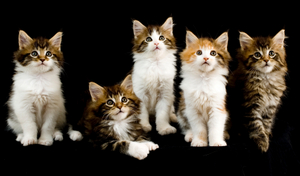Cats are only pregnant for about two months, which is quite short compared to other mammals. For cats, giving birth as early as the 57th day or as late as the 65th day are not uncommon. The mother cat (called a queen by cat breeders) soon goes into heat after the birth of her kittens, which means she could conceivably conceive yet another litter while nursing the first litter. This is something that should be avoided for the good of the queen, the good of the kittens and the good of the pet population in your area.
The Queen’s Mating Cycle
On average, a queen goes into her first heat when she is about six months old. Although she is so young, she can get pregnant at this time. Many first time queens have small litters, but not always. A cat usually has anywhere from one to ten kittens. The world record for most kittens born in a litter was 19, born to a purebred Burmese named Tarrawood Antigone on August 7, 1970. Only 15 kittens survived. There are no certainties when it comes to kittens.
After the first heat cycle, things get a little complicated for the unspayed queen. She just doesn’t come into estrus on a regular cycle or come into heat only once a year (like a lot of female mammals). A lot depends on the length of daylight, access to males and individual quirks. Most queens do not come into heat during the fall and winter.
The first phase of a queen’s heat cycle is called “proestrus”, where she starts thinking about going out to party with all of the available tom cats in the neighborhood. She won’t them mate with her at this time and, even if she was bred, she won’t get pregnant. She will wait for her estrus, which can last anywhere from two to twenty days.
If she doesn’t get pregnant or experience a false pregnancy (and the weather is good), she’ll go through the cycle again.
Spaying
The world record for the number of kittens a queen has given birth to in her lifetime is 420, held by a (presumably) very tired Dusty, who lived in the 1940’s and early 1950’s. Usually, people don’t track how many kittens a queen can have in her lifetime, but they can have a lot and all of the kittens need homes. But, there just aren’t homes available.
Also, not being spayed takes a tremendous physical toll on the queen. And she is susceptible to cancer of the reproductive organs. She poses less of a chance of getting breast cancer if spayed early than spayed after several litters. She will risk getting killed from trying to escape and carouse with the local toms. Get her spayed as soon as your vet says you can. This will save a lot of money and aggravation in the future.
References:
Cat Owner’s Home Veterinary Handbook.” Delbert G. Carlson, DVM, et al. Howell Book House; 1995.
PawsOnline: “Feline Statistics” http://www.pawsonline.info/feline_statistics.htm
Four Paws Veterinry Clinic: “Amazing Cat Facts.” http://www.fourpawsvetclinic.com/content/view/34/54/
LSU School of Veterinary Medicine. “Feline Estrous Cycle.” http://www.vetmed.lsu.edu/eiltslotus/theriogenology-5361/filne_e.htm
Pet Education.com: “Mammary Cancer in Cats” http://www.peteducation.com/article.cfm?c=1+1376&aid;=220








